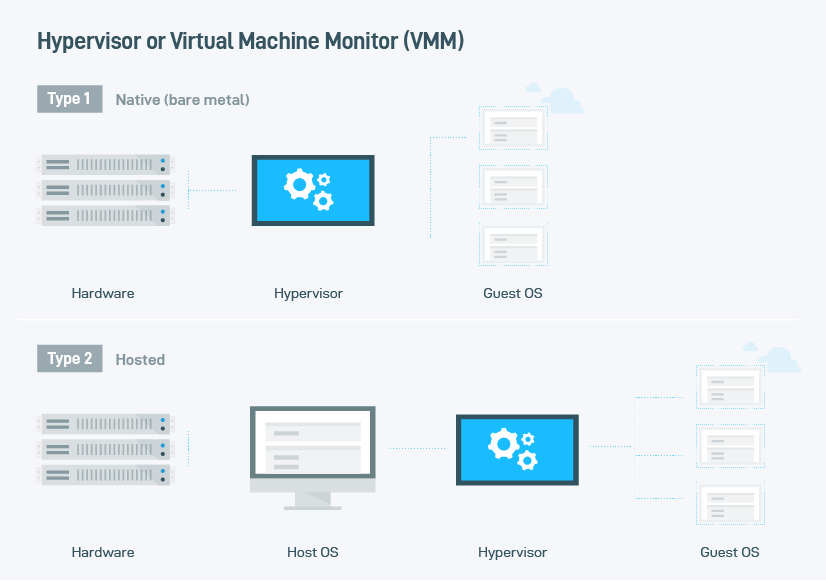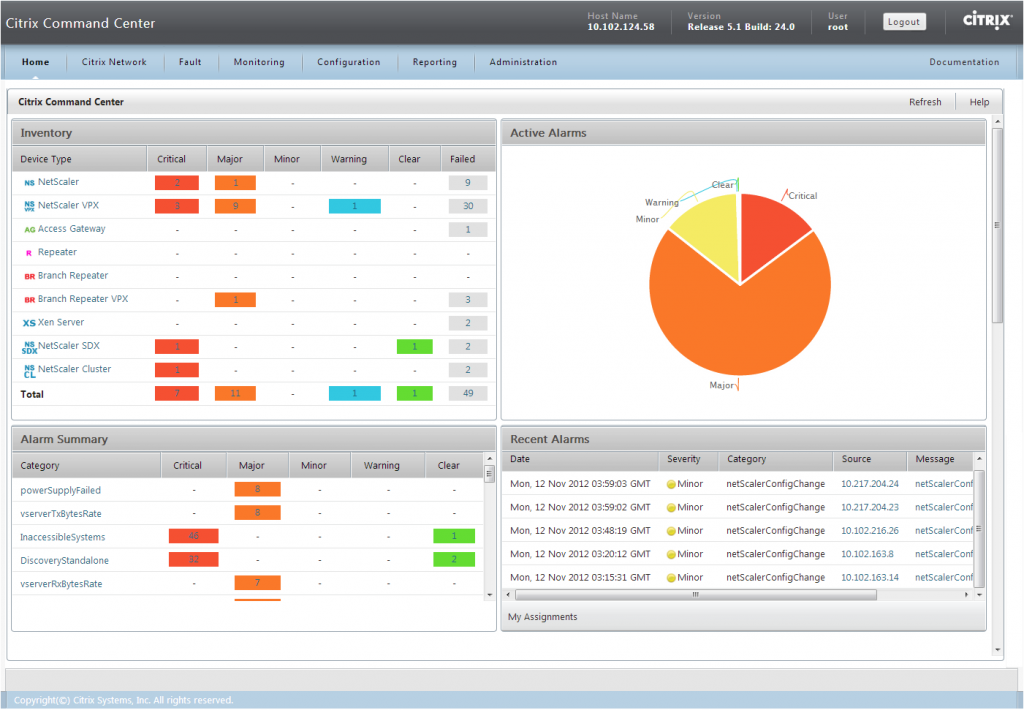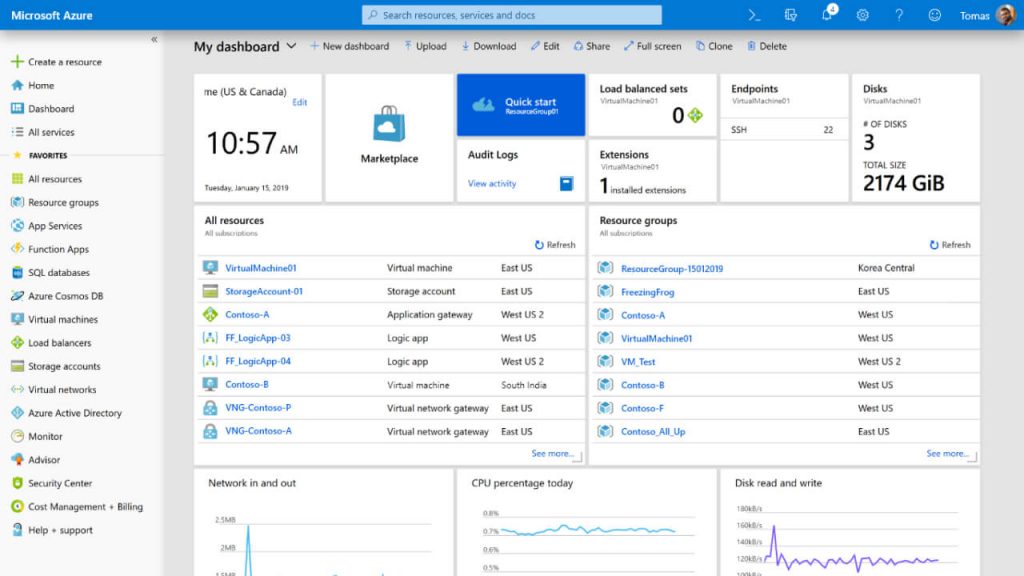
Introduction
Server virtualization currently is a trending topic in the IT world. Its popularity and adoption keeps growing, especially in enterprise environments. Hypervisors are part of the broad area of computing known as “virtualization,” a concept that has been around for half a century.
Ultimately, the goal of a hypervisor is to allow sharing of hardware resources,like an operating system (OS) does. In this article we will discuss, What is Hypervisor? Types of Hypervisors, How does Hypervisor work? Advantages of using Hypervisor and top 5 Hypervisor tools.
What is a Hypervisor?
A hypervisor is hardware, software, or firmware capable of creating virtual machines and then managing and allocating resources to them. Hypervisors create a virtualization layer that separates CPU / Processors, RAM and other physical resources from the virtual machines you create.
The machine we install a hypervisor on is called a host machine, versus guest virtual machines that run on top of them.
Hypervisor is primarily divided into two types based on their working:
- Type 1 hypervisor- It runs on the host hardware directly. These are also called as bare-metal hypervisor.
- Type 2 hypervisor- It runs on a software i.e. an operating system. System administrators use both types of open source hypervisornbased on their specific needs.

What are the features of a hypervisor?
- Partitioning- Hypervisors partition the underlying hardware.
- Resource Distribution- Hypervisors manage independent virtual machines by distributing resources like memory, network bandwidth, etc.
- Start/Stop- Upon the request of the user, hypervisors can start/stop the independent virtual machines.
- Isolation- Hypervisors ensure that the virtual machines are isolated from each other. This further ensures that a problem in one virtual machine does not affect the other.
- Communication- The hypervisor also handles the communication amongst virtual machines over virtual networks, enabling VMs to connect with one other.
How Does a Hypervisor Work?
Hypervisor is the one key component that makes virtual machines possible. They are used for various different tasks in a business setting, including data replication, server consolidation, desktop virtualization, and cloud computing.
- Hypervisors operate on the server level, and can be either physical or virtual, and hardware or software-defined
- Hypervisors load the client operating systems of the VMs
- The hypervisor distributes the computing resources such as CPU, memory, bandwidth, and disk storage for each of the VMs. It does this by creating pools of hardware resources, which it then allocates to VMs.
- VMs can create requests for the hypervisor through API calls.
If you have a business with multiple servers operating different services for customers over the internet, it can become difficult to centrally manage them all, especially if they run different operating systems. A hypervisor lets you visualize these servers, then manage them all in one physical machine, so they operate more efficiently.
What are the advantages of Hypervisor?
- With a hypervisor, you can successfully run and monitor concurrent virtual machines on a host.
- It make co-existing possible on one system and consolidate workloads and multiple operating environments.
- Hypervisor secures the operating environment from internal conflicts.
- It removes any dependency over physical OS and applications.
- Without accessing host resources, hypervisors achieve a better level of computing performance, availability, and scalability.
Now let’s move on to the list, depending upon their infrastructure and needs for managing virtualization a business can choose the reqiured tool. So here is a list of top 10 hypervisor tools, which are used by professionals.
1.Citrix Hypervisor

Citrix Hypervisor is a leading virtualization management platform optimized for application, desktop and server virtualization infrastructures. The basic version is free, but advanced features are restricted to paid tier releases.
Paying customers get sophisticated management tools, the ability to automate and distribute live environments at will. It also has the GPU pass-through and virtualized GPU capabilities, allowing it to offer virtualized CAD and it’s also entirely managed to enable faster deployment of new desktops, reduced maintenance burden, and maximum uptime. It’s also a cloud platform, making it a great choice for businesses wanting to empower their workforces with unparalleled flexibility and mobility.

Features-
- Creating VMS – virtualizing physical or already virtual images is a snap
- Configuration – in a smaller environment, configuration is simple and easy to understand
- Templates and Clones – the ability to create these on the fly make it great for a dev environment
- Very good integration with other tools.
- The support from the vendor is very good.
Citrix XenServer: What is server virtualization?
2. Azure Virtual Machines

It is one of the services provided by Azure to create your own instances. Azure Virtual machine will let us create and use virtual machines in the cloud as Infrastructure as a Service. We can use an image provided by Azure, or partner, or we can use our own to create the virtual machine.
Virtual machines can be created and managed using:
- Azure Portal
- Azure PowerShell and ARM templates
- Azure CLI
- Client SDK’s
- REST APIs

Features-
- Cost effective- It charges you only pay for the compute time you use
- Scalable- Scale from one to thousands of VM instances in minutes.
- Security- Encrypt sensitive data, protect VMs from malicious threats, secure network traffic and meet regulatory and compliance requirements.
- VM extension, which gives additional capabilities such as running anti-virus etc.
3. VMware ESXi

VMware ESXi is a bare-metal hypervisor which is currently an industry-leading service due to its large array of features. An ESXi hypervisor is provided as a part of VMware vSphere which, in turn, comes with different licensing options for each edition.
ESXi provides a virtualization layer that abstracts the CPU, storage, memory and networking resources of the physical host into multiple virtual machines. That means that applications running in virtual machines can access these resources without direct access to the underlying hardware. VMware refers to the hypervisor used by VMware ESXi as vmkernel. vmkernel receives requests from virtual machines for resources and presents the requests to the physical hardware.

Features-
- Virtualization – it allows you to take full advantage of your hardware investments
- Flexibility – it allows you to run services across disparate hardware types
- Scalability – it allows you to expand and deploy new services rapidly
Introduction to Virtualization and VMware Hypervisor
4. Oracle VirtualBox

Oracle VM VirtualBox is free and incredibly reliable, and it runs on a variety of host systems, including OS X. With this, you can transport live virtual machines from one host or cloud to another without the process interrupting its operation. As such, you have maximum flexibility when it comes to the placements of your virtual machines.
Oracle VM VirtualBox also gives you the ability to take snapshots of your virtual machines. This lets you save their current state for future restoration in case you encounter problems. Apart from that, you can use snapshots to switch between histories, creating a sort of alternate realities so you can configure your machines in different ways with ease.

Features
- Cross-Platform Virtualization
- Guest Additions
- Guest Multiprocessing
- USB Device Support
- ACPI Support
- Multiscreen Resolutions
- Built-In iSCSI Support
- PXE Network Boot
- Branched Snapshots
- VM Groups
- Remote Machine Display
- Extensible RDP Authentication
Oracle Virtual box
5.QEMU

Stands for Quick Emulator. It is a hardware virtualization hypervisor. This product slightly differs from other VM solutions is that it is both a VM host and also a machine emulator. Along with x86 PC, QEMU can emulate PowerPC, MIPS64, ARM, SPARC (32 and 64), MicroBlaze, ETRAX CRIS, SH4 and RISC-V, among others.
It manages to do this without administrator privileges, and the performance of VMs running on it is close to that of native installations. QEMU provides an extensive list of APIs for device development and control.
The QEMU machine emulator and visualizer also allow developers to securely test device drivers, find and fix defects which can crash the entire operating system. Developing and debugging drivers on an emulator makes working with them similar to working with user-space applications.
Features-
- Multiple architectures are supported by default.
- Can simulate IA-32 ( x86 ) PC, AMD 64 PC, MIPS R4000, Sun SPARC sun3 and PowerPC (PReP and Power Macintosh) architecture
- Scalable to customize new instruction sets
- Open source, portable, fast simulation
- On the x86 architecture that supports hardware virtualization, one can use KVM to accelerate with the kernel ksm large page backup memory, which is much faster than VMware ESX.
- Increased simulation speed, some programs can even run in real time
- Programs that can run Linux on other platforms
- Can store and restore operating status (such as running programs)
- Virtual network card.
Introduction to QEMU
Conclusion
So, these are some best hypervisor options, It is critical to choose the best hypervisor software when setting up virtualization. I often heard people asking what the best hypervisor software is? There is significant hypervisor software out there that are available either proprietary software or as open source. If you are looking into virtualizing your existing infrastructure or set up a new environment; you have to select the software that is within your budget and can deliver the best result.
I’m a DevOps/SRE/DevSecOps/Cloud Expert passionate about sharing knowledge and experiences. I am working at Cotocus. I blog tech insights at DevOps School, travel stories at Holiday Landmark, stock market tips at Stocks Mantra, health and fitness guidance at My Medic Plus, product reviews at I reviewed , and SEO strategies at Wizbrand.
Do you want to learn Quantum Computing?
Please find my social handles as below;
Rajesh Kumar Personal Website
Rajesh Kumar at YOUTUBE
Rajesh Kumar at INSTAGRAM
Rajesh Kumar at X
Rajesh Kumar at FACEBOOK
Rajesh Kumar at LINKEDIN
Rajesh Kumar at PINTEREST
Rajesh Kumar at QUORA
Rajesh Kumar at WIZBRAND

 Starting: 1st of Every Month
Starting: 1st of Every Month  +91 8409492687
+91 8409492687  Contact@DevOpsSchool.com
Contact@DevOpsSchool.com
